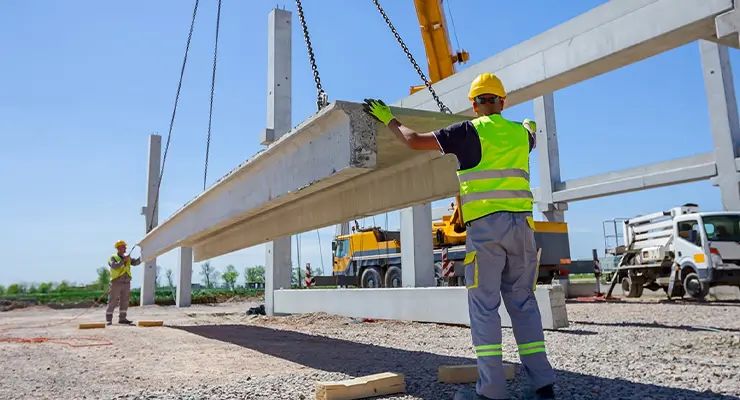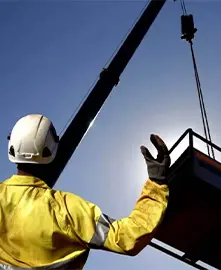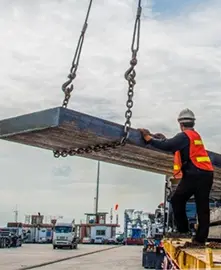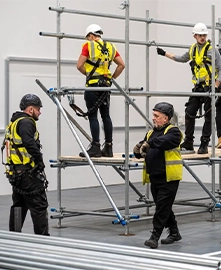Our Services
- Third Party Inspection
- Safety Training Service
- Lifting Equipment Inspection
- Advanced & Conventional NDT
- Calibration Service
- Material Testing Laboratories
- Marine Testing Laboratories
- IPAF Training MEWP's
- Test Weight & Load Cell Rental
- ISO Audit & Certifications Consultancy
- Rigging & Technical Training
- Operator Training & Assessment
- Coating Inspection
- Scaffolding Inspection & Consultancy
- Asset Integrity
- Elevator / Escalator Inspection
- Amusement Rides / Fair Groundplay Inspection
- Warehouse Inspection
- Rigging & Lifting Consultancy Service
- Technical Manpower Service
- Equipment Maintenance Service
- Accident Investigation
Technical Certification Program

Rigger I, II, III certification Program:
A qualified rigger is defined as a qualified person who has successfully demonstrated the ability to solve rigging problems by having a recognized degree or certification by extensive knowledge, experience and training. At Standard Arabia we are providing Rigger level 1, 2&3 training program. This program includes technical training as well as the practical examination to meet the standards to make sure that participants have good hand on both theory and practical so they can conduct proper inspection of rigging gears, slings, shackles, hooks, eye bolts, spreader beams, wire ropes and can perform lifting operations in a safe manner.
Rigger Level III:
Given tools, equipment and material, participant will lift and move the load up to a maximum of 10 ton to a predetermined location as per the international codes of practice.
The candidate must:
Determine the correct method of rigging the load.
Select the appropriate equipment with reference to size and capacity.
Conduct a pre-use inspection of the equipment.
Rig the load.
Lift the load.
Move the Load
Conduct a post-use inspection of the equipment.
Determine proper hand signals.
Rigger Level II:
Rigger Level 2 training is designed to give knowledge to those people who are doing lifting activities. This course will cover responsibilities of rigger level 2 and different standards and requirements for rigging and lifting activities. By the end of this training program the student will have the knowledge to perform his duties safely and understand the terms, equipment and procedures commonly used in basic rigging and lifting operations as per the International Codes of Practice.
The candidate must:
Inspect the work site.
Complete a detailed lift plan.
Determine the correct method of rigging the load.
Select the appropriate equipment with reference to size and capacity.
Conduct a pre-use inspection of the equipment.
Check the validity of Crane Operator and Crane Inspection Certificates
Conduct a Pre-Lift Safety Talk/Toolbox Talk.
Rig the load.
Lift the load up to 40 tons.
Move the Load
Conduct a post-use inspection of the equipment.
Rigger Level I:
When working on any site, safety must be the priority for the individual and this is addressed throughout this training program. Not only the basic safety procedures when working on a client site but also the specific safety concerns related to rigging practices and working around a mobile crane. When performing the job of a rigger 1 the student will be required to lift loads of varying weight and shape using different techniques and lifting equipment. This program is designed to ensure the student has the knowledge to perform his duties safely and competently.
The candidate must:
Understand the responsibilities of Rigger 1
Rigging principals and terminologies
Rigging and lifting regulations.
Rigging gears inspection and use.
Multi sling calculations.
Finding center of gravity
Lifting plan generation and approval.
Lift plan and selection of suitable crane.
Hand signals
Planning and execution
Tandem lifting
Critical lifting
Super lifting
Scaffolding Training program:
A scaffold is a temporary elevated working structure used to support workers and material during the construction, maintenance or repair of buildings and other structures. Everyday construction workers stand on scaffolds for extended periods of time as part of their jobs. Working on these temporary elevated structures inevitably carries the potential risk of accidents. Therefore, this is mandatory for employers to arrange complete training of workers and conduct proper inspection of scaffolds to ensure the integrity of the structures, to prevent accidents, serious injuries and fatalities.
At standard arabia we provide scaffolding safety, scaffolding supervisor and scaffolding inspector training as per OSHA 1926.451 standard. By the end of these course participants will be able to properly erect, dismantle scaffoldings, will be able to identify scaffolding hazards and will learn the proper inspection procedure of scaffolds.





